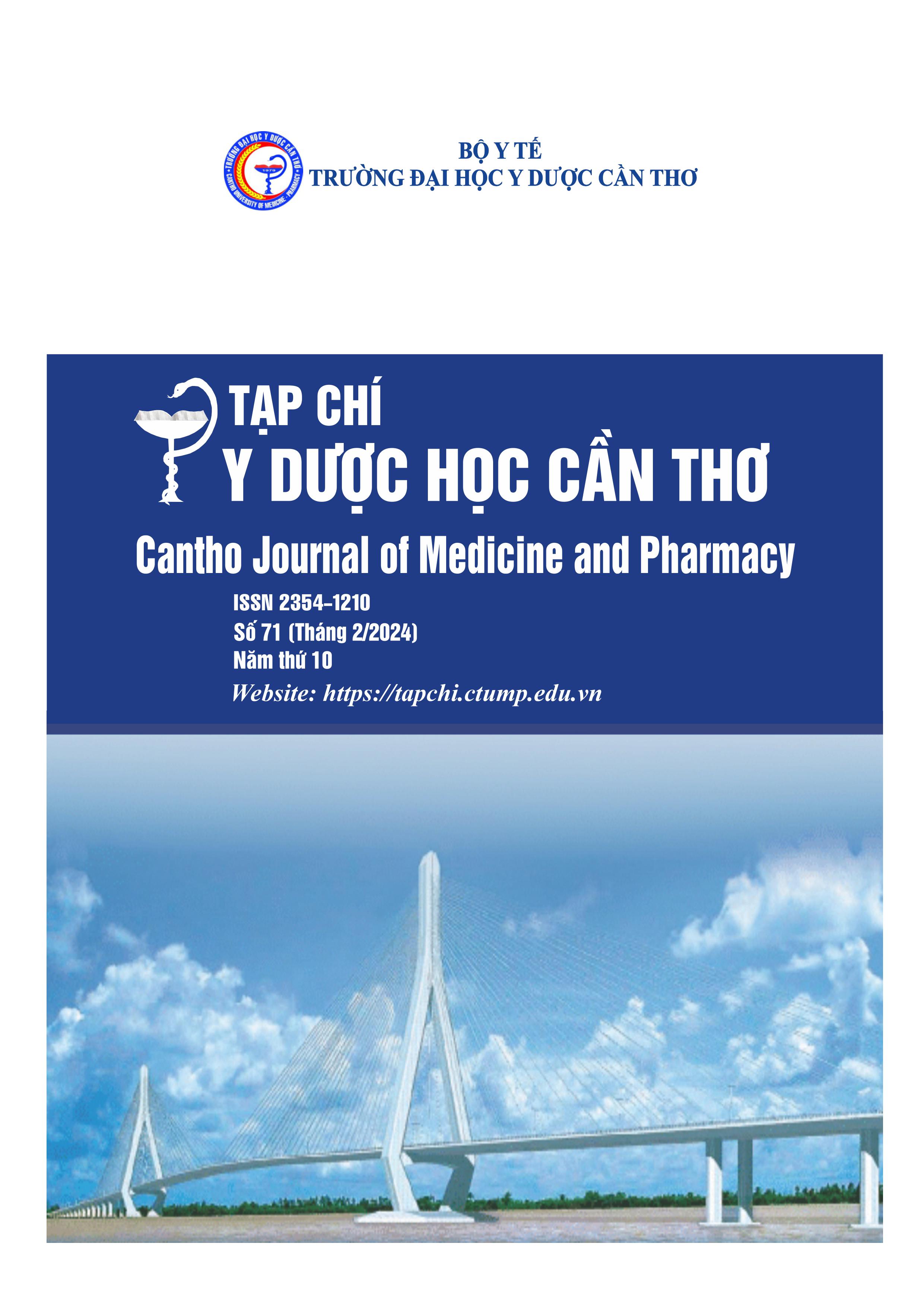STUDY ON LEVOFLOXACIN RESISTANCE MUTATIONS OF HELICOBACTER PYLORI BACTERIA IN CHILDREN WITH GASTRITIS AND PEPTIC ULCER AT CAN THO CHILDREN'S HOSPITAL IN 2021-2023
Main Article Content
Abstract
Background: Levofloxacin is considered a rescue antibiotic in the treatment H.pylori due to a high resistance to clarithromycin and the restriction of tetracycline use only in older children. However, the resistance to levofloxacin is currently increasing, varying between regions worldwide, and the resistance situation is associated with mutations in the specific areas of the quinolone resistance gene GyrA. Objectives: To determine the rate of GyrA gene mutations resistant to levofloxacin of H. pylori bacteria in children 6-16 years old with peptic ulcers and some related factors. Materials and methods: A cross-sectional descriptive study was conducted on 55 pediatric patients aged 6-16 with H.pylori-positive gastroduodenitis at Can Tho Children's Hospital from January 2021 to January 2023. Results: In pediatric patients infected with H. pylori, the mutation rate of the GyrA gene is 54.5%. The two most common variants are amino acid positions 87 and 91, with mutation rates conferring resistance to levofloxacin at N87K, D91G, D91Y, and D91N being 38.2%, 7.3%, 1.8%, and 1.8%, respectively. Particularly noteworthy are three newly discovered mutations with potential levofloxacin resistance: A88V, K133N, and A134P, each with an equal rate of 1.8% Conclusion: The study has determined the rate of drug resistance mutations and levofloxacin antibiotic resistance mutations in H. pylori bacteria. In addition, the study also showed that mutations in the GyrA gene were not related to the levofloxacin resistance phenotype.
Article Details
Keywords
H.pylori, levofloxacin, antibiotic resistance, gene sequencing
References
2. Quach DT, Mai BH, Tran MK, et al. Vietnam Association of Gastroenterology (VNAGE) consensus on the management of Helicobacter pylori infection. Frontiers in medicine. 2022. 9, 1065045, doi:10.3389/fmed.2022.1065045.
3. Van Thieu H, Duc NM, Nghi BTD, et al. Antimicrobial Resistance and the Successful Eradication of Helicobacter pylori-Induced Gastroduodenal Ulcers in Vietnamese Children. Medical archives (Sarajevo, Bosnia and Herzegovina). 2021. 75(2), 112-115, doi:10.5455/medarh. 2021.
4. Tăng Lê Châu Ngọc, Nguyễn Anh Tuấn, Nguyễn Minh Ngọc, Nguyễn Trọng Trí, Võ Hoàng Khoa và cộng sự. Đặc điểm đề kháng kháng sinh và đáp ứng điều trị trên trẻ viêm dạ dày do Helicobacter Pylori. Y học Thành phố Hồ Chí minh. 2018. 1-5.
5. Nguyễn Thị Hồng Nhân, Nguyễn Thị Việt Hà. Triệu chứng lâm sàng và tổn thương trên nội soi của bệnh nhân loét dạ dày tá tràng do H. pylori ở trẻ em tại bệnh viện đa khoa Saint Paul. Tạp Chí Y học Việt Nam. 2020. 494(2), 202-205.
6. Zhang Y, Wen Y, Xiao Q, Zheng W, Long G, Chen B, Shu X, Jiang M. Mutations in the Antibiotic Target Genes Related to Clarithromycin, Metronidazole and Levofloxacin Resistance in Helicobacter pylori Strains from Children in China. Infect Drug Resist. 2020. 30(13), 311-322, doi: 10.2147/IDR.S235615. eCollection 2020.
7. Nguyễn Thành Nam. Nghiên cứu tình hình phát hiện vi khuẩn Helicobacter pylori trong nước bọt bằng kỹ thuật REAL-TIME PCR trên bệnh nhân viêm, loét dạ dày-tá tràng tại Bệnh viện trường đại học Y Dược Cần Thơ năm 2020-2021. Luận văn thạc sỹ xét nghiệm Y học. Trường Đại học Y Dược Cần Thơ. 2021. 88.
8. Nguyễn Văn Khoa. Ứng dụng kỹ thuật etest xác định kháng thuốc và kỹ thuật giải trình tự gen phát hiện đột biến kháng levofloxacin của vi khuẩn Helicobacter pylori ở bệnh nhân viêm dạ dày tại Bệnh viện Đa khoa trung tâm Tiền Giang năm 2020-2021. Luận văn thạc sỹ xét nghiệm Y học. Trường Đại học Y Dược Cần Thơ. 2021. 110.
9. Trần Đức Long, Nguyễn Trung Kiên, Nguyễn Thị Thu Cúc. Tình hình nhiễm Helicobacter pylori, đặc điểm lâm sàng và hình ảnh nội soi ở trẻ viêm loét dạ dày tá tràng từ 6-15 tuổi tại Bệnh viện
Nhi đồng Cần Thơ. Tạp chí Y Dược học Cần Thơ. 2019. 19, 1-8.
10. Trần Thị Như Lê, Nguyễn Vũ Trung, Trần Ngọc Ánh. Đột biến kháng levofloxacin trên gen GyrA, gyrB của Helicobacter pylori trên bệnh nhân viêm loét dạ dày - tá tràng. Tạp chí nghiên cứu Y học. 2021. 150, 69-70, doi.org/10.52852/tcncyh.v150i2.727. 11. Trần Đoàn Hậu, Huỳnh Văn Trương, Trần Quốc Tường, Nguyễn Tuấn Anh, Võ Phạm Trung Hiếu.
nghiên cứu đột biến kháng clarithromycin và levofloxacin của vi khuẩn helicobacter pylori ở bệnh nhân viêm dạ dày tại bệnh viện đa khoa bạc liêu và bệnh viện đa khoa thanh vũ medic bạc liêu năm 2022-2023. Tạp chí nghiên cứu Y học. 2023. 61,177-178.
12. Miyachi H, Miki I, Aoyama N, et al. Primary levofloxacin resistance and GyrA/B mutations among helicobacter pylori in Japan. Helicobacter. 2006,11,243–249.
13. Miftahussurur M, Shrestha PK, Subsomwong P, Sharma RP, Yamaoka Y. Emerging Helicobacter pylori levofloxacin resistance and novel genetic mutation in Nepal. BMC Microbiol. 2016. 4,16(1), 256, doi: 10.1186/s12866-016-0873-6.
14. Garcia M, Raymond J, Garnier M, Cremniter J, Burucoa C. Distribution of spontaneous GyrA mutations in 97 fluoroquinolone-resistant Helicobacter pylori isolates collected in France. Antimicrobial Agents and Chemotherapy. 2012. 56(1), 550-551, DOI: 10.1128/aac.05243-11.
15. Đặng Ngọc Quý Huệ. Nghiên cứu tỷ lệ kháng clarithromycin, levofloxacin của Helicobacter pylori bằng Epsilometer và hiệu quả của phác đồ EBMT ở bệnh nhân viêm dạ dày mạn. Luận án Tiến sĩ Y học. Trường Đại học Y Dược Huế. 2018. 213.
16. Zerbetto De Palma G, Mendiondo N, Wonaga A, Viola L, Ibarra D, Campitelli E, Salim N, Corti R, Goldman C, Catalano M. Occurrence of Mutations in the Antimicrobial Target Genes Related to Levofloxacin, Clarithromycin, and Amoxicillin Resistance in Helicobacter pylori Isolates from Buenos Aires City. Microb Drug Resist. 2017. 23(3), 351-358, doi: 10.1089/mdr.2015.0361.


